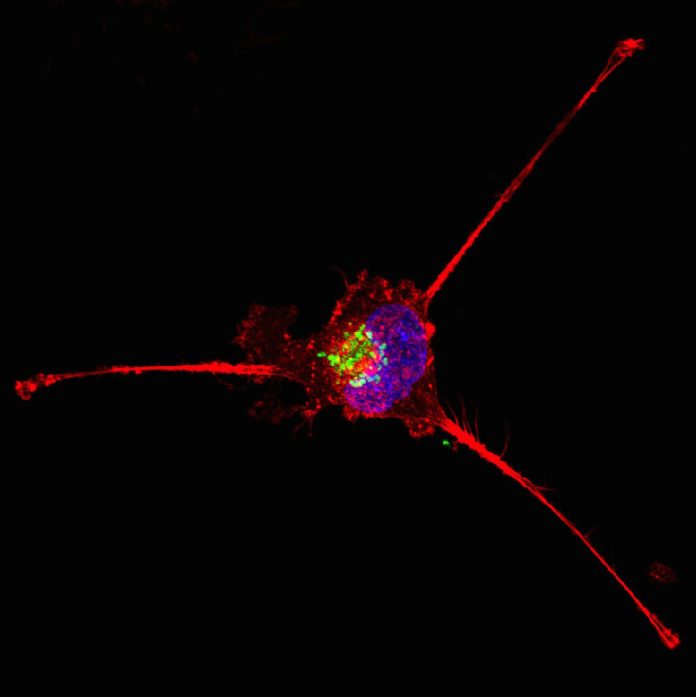
The phase II TBCRC 043 trial, led by researchers at Vanderbilt University, shows that adding atezolizumab to carboplatin chemotherapy significantly improves outcomes among patients with metastatic triple-negative breast cancer (TNBC), and provides key information about immunotherapy response in these patients.
The improved response with atezolizumab was evident regardless of PD-L1 status, and was greater among people with increased tumor infiltrating lymphocytes (TILs), higher tumor mutational burden (TMB), obesity, and uncontrolled blood glucose levels, reports Brian Lehmann, PhD, research associate professor of Medicine at Vanderbilt University, and co-authors in JAMA Oncology.
“Our findings add to the growing evidence that immunotherapy combined with differing chemotherapy backbones can significantly improve the survival of patients with metastatic TNBC,” Lehmann and second author Vandana Abramson, MD, tell Inside Precision Medicine.
Abramson, who is the Donna S. Hall Professor in Cancer Research and co-leader of the Breast Cancer Research Program at Vanderbilt-Ingram Cancer Center, adds: “Triple-negative breast cancer is difficult to treat because we don’t have a clear target, and understanding the underlying factors that affect response to a treatment is key. This study is so important because we were able to collect biopsies in all participants and really understand factors that affect response.”
The researchers initiated the study in 2017 because, at that time, the effect of combining platinum compounds like carboplatin with anti-PD-1/PD-L1 immunotherapy had not been extensively determined. In contrast to microtubule-targeting agents such as nab-paclitaxel, which had been previously tested in combination with atezolizumab with limited clinical benefit, carboplatin causes structural DNA changes and generates neoantigens that may stimulate an immune response.
In total, 106 patients with metastatic TNBC were randomly assigned to receive carboplatin alone (n=56) or in combination with atezolizumab 1200 mg (n=50) every 3 weeks until disease progression or unacceptable toxicity, with a maximum 3 years of follow-up.
Lehmann et al report that patients given atezolizumab had a non-statistically significant 34% lower risk for disease progression or death than those who did not receive the immunotherapy, with median progression-free survival at 4.1 and 2.2 months, respectively.
Overall survival was 12.6 months in the combination therapy arm and 8.6 months in the monotherapy arm, with the difference corresponding to a significant 40% lower risk for death in favor of atezolizumab.
At 6 months, the objective response rate was 30.4% among patients given atezolizumab plus carboplatin and 8.0% among those treated with carboplatin monotherapy, while the clinical benefit rates were a respective 37.5% and 18.0%.
Lehman and Abramson point out that their trial design allowed patients receiving carboplatin alone to switch to atezolizumab monotherapy upon disease progression. Patients who did this had similar median overall survival to those receiving the combination.
Furthermore, the team observed “far fewer toxicities in patients receiving sequential therapy, suggesting this may be another option for those patients in which clinical toxicity management is critical,” Lehman and Abramson remarked. “This is especially important given the potential for severe immune-related toxicities that can lead to lifelong debilitating conditions that come with immunotherapy.”
The combination therapy was generally well-tolerated, and toxic effects were consistent with previous reports for atezolizumab. The most common adverse events in the combination arm were low blood platelet counts, anemia, lymphocytopenia, nausea, fatigue, and increased liver enzymes. Serious adverse events were reported in 41% of patients given atezolizumab and 8% of those who did not receive immunotherapy.
The investigators also looked at how the response to atezolizumab correlated with tumor PD-L1 levels, TILs, TNBC subtypes, and immune markers. These analyses showed that “patients receive benefit regardless of PD-L1 status and that the tumors with high mutational burdens and with infiltrating lymphocytes receive the most benefit,” say Lehman and Abramson.
The risk for disease progression or death among people with high TIL levels was a significant 88% lower with, versus without atezolizumab, whereas there was no significant benefit of adding immunotherapy among patients with low TILs. Similarly, individuals with a high TMB who received atezolizumab had a 67% lower risk for disease progression or death than those who did not, while the risk reduction was 33% in people with a low TMB.
In addition, patients with obesity and those with diabetes were more likely to benefit from immunotherapy than those without these baseline characteristics.
There are currently four subtypes of TNBC: Two basal-like subtypes, a mesenchymal subtype, and a lumen androgen receptor (LAR)-expressing subtype. Patients with the basal-like and mesenchymal subtypes derived greater benefit from combination therapy than from monotherapy but those with the LAR subtype did not.
Lehman and Abramson believe this finding provides “further evidence that the LAR subtype is more like hormone receptor-positive disease and needs to be considered apart from TNBC.”
Since the trial began, the treatment and outcomes of patients with TNBC has advanced substantially, and Lehman and Abramson acknowledge that these improvements make “the use of atezolizumab in combination with carboplatin is hard to justify broadly across metastatic TNBC.”
They nonetheless believe that their “correlative studies provide a framework for understanding response to immunotherapy as a whole.”













